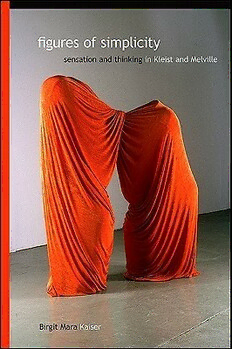
Figures of simplicity: sensation and thinking in Kleist and Melville PDF
Preview Figures of simplicity: sensation and thinking in Kleist and Melville
PHILOSOPHY / LITERATURE (cid:25)(cid:10)(cid:22)(cid:19)(cid:8)(cid:20)(cid:1)(cid:17)(cid:9)(cid:1)(cid:20)(cid:12)(cid:15)(cid:18)(cid:14)(cid:12)(cid:6)(cid:12)(cid:21)(cid:24) f Figures of Simplicity explores i (cid:20)(cid:8)(cid:16)(cid:20)(cid:5)(cid:21)(cid:12)(cid:17)(cid:16)(cid:1)(cid:5)(cid:16)(cid:7)(cid:1)(cid:21)(cid:11)(cid:12)(cid:16)(cid:13)(cid:12)(cid:16)(cid:10)(cid:1)(cid:12)(cid:16)(cid:1)(cid:3)(cid:14)(cid:8)(cid:12)(cid:20)(cid:21)(cid:1)(cid:5)(cid:16)(cid:7)(cid:1)(cid:4)(cid:8)(cid:14)(cid:23)(cid:12)(cid:14)(cid:14)(cid:8) g a unique constellation of figures from u r philosophy and literature—Heinrich von e s Kleist, Herman Melville, G. W. Leibniz, and o Alexander Baumgarten—in an attempt to f s recover alternative conceptions of aesthetics i m and dimensions of thinking lost in the Birgit Mara Kaiser is Assistant p Professor of Comparative Literature at li disciplinary narration of aesthetics after Kant. c This is done primarily by tracing a variety Utrecht University in the Netherlands. i t y of “simpletons” that populate the writings of Kleist and Melville. These figures are not entirely ignorant, or stupid, but simple. Their simplicity is a way of thinking, one that Birgit Mara Kaiser suggests is affective thinking. Kaiser avers that Kleist and Melville are experimenting in their texts with an affective mode of thinking, and thereby continue a key line within eighteenth-century aesthetics: B the relation of rationality and sensibility. i r Through her analyses, she offers an outline g i of what thinking can look like if we take t M affectivity into account. a r a K a i s e r A Volume in the SUNY series, Intersections: Philosophy and Critical Theory Rodolphe Gasché, editor State University of New York Press www.sunypress.edu (cid:2)(cid:12)(cid:19)(cid:10)(cid:12)(cid:21)(cid:1)(cid:4)(cid:5)(cid:19)(cid:5)(cid:1)(cid:3)(cid:5)(cid:12)(cid:20)(cid:8)(cid:19) Figures of Simplicity SUNY series, Intersections: Philosophy and Critical Theory Rodolphe Gasché Figures of Simplicity Sensation and Thinking in Kleist and Melville Birgit Mara Kaiser Published by State University of New York Press, Albany © 2011 State University of New York Cover illustration, photograph of “The Match” (2003, fabric and Styrofoam) by Frances Bagley. Reproduced with permission of the artist. All rights reserved Printed in the United States of America No part of this book may be used or reproduced in any manner whatsoever without written permission. No part of this book may be stored in a retrieval system or transmitted in any form or by any means including electronic, electrostatic, magnetic tape, mechanical, photocopying, recording, or otherwise without the prior permission in writing of the publisher. For information, contact State University of New York Press, Albany, NY w ww.sunypress.edu Production by Kelli W. LeRoux Marketing by Michael Campochiaro Library of Congress Cataloging-in-Publication Data Kaiser, Birgit Mara. Figures of simplicity : sensation and thinking in Kleist and Melville / Birgit Mara Kaiser. p. cm. — (Suny series, intersections: philosophy and critical theory) Includes bibliographical references and index. ISBN 978-1-4384-3229-8 (hardcover : alk. paper) 1. Melville, Herman, 1819–1891—Criticism and interpretation. 2. Kleist, Heinrich von, 1777–1811—Criticism and interpretation. 3. Thought and thinking in literature. 4. Senses and sensation in literature. 5. Literature, Comparative—American and German. 6. Literature, Comparative—German and American. I. Title. PS2388.T53K35 2010 813'.3–dc22 2009054369 10 9 8 7 6 5 4 3 2 1 Il y a deux manières de dépasser la fi guration (c’est-à-dire à la fois l’illustratif et le narratif): ou bien vers la forme abstraite, ou bien vers la Figure. Cette voie de la Figure, Cézanne lui donne un nom simple: la sensation. La Figure, c’est la forme sensible rapportée à la sensation. La sensation, c’est le contraire du facile et du tout fait, du cliché, mais aussi du « sensationnel », du spontané, etc. La sensation a une face tournée vers le sujet […] et une face tournée vers l’objet […]. Ou plutôt elle n’a pas de faces du tout, elle est les deux choses indissolublement […]. Gilles Deleuze, Francis Bacon. Logique de la Sensation v Contents Acknowledgments ix Abbreviations xi Introduction: On Subterranean Connections xiii 1. Aesthetics: Sensation and Thinking Reconsidered 1 The Copernican Turn 7 The Folds of Small Perceptions 11 Sensate Thinking 19 Figures of Simplicity 22 2. Sentimentalities 27 Befuddling the Senses (The Betrothal in St. Domingo) 31 Spectacularly Simple: Well-Willingly Seeing Nothing (Benito Cereno) 41 Sentimentalizing Resentment 53 3 . Affectivity 56 Resolute Simplicity (Billy Budd, Sailor. An inside narrative) 62 Calculating Mindlessness (Michael Kohlhaas) 76 Baroque Heroes 85 4. Insistence 88 On Passive Resistance (Bartleby, the Scrivener. A story of Wall-Street) 90 vii Figures of Simplicity Lingering before Consciousness (Das Käthchen von Heilbronn oder Die Feuerprobe) 96 Supersensible Figures of the Fold 109 5 . Conclusion 113 Notes 120 Bibliography 139 Index 146 viii
